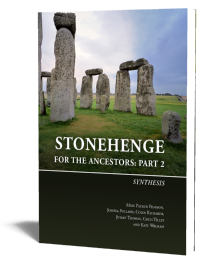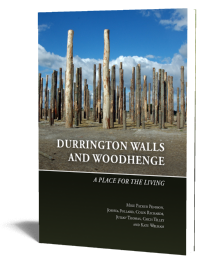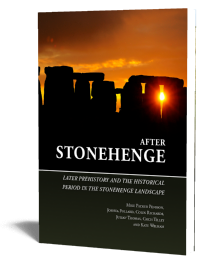Stonehenge for the Ancestors: Part 1
Landscape and Monuments
Mike Parker Pearson, Joshua Pollard, Colin Richards, Julian Thomas, Chris Tilley & Kate Welham | 2020
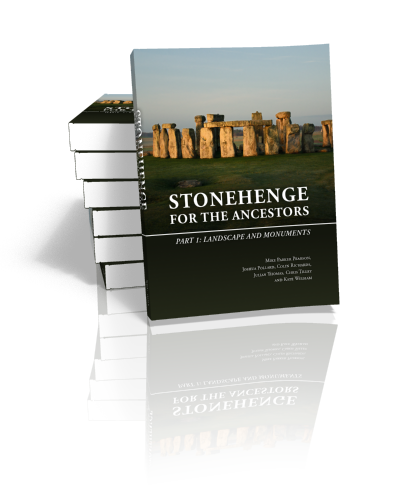
Stonehenge for the Ancestors: Part 1
Landscape and Monuments
Mike Parker Pearson, Joshua Pollard, Colin Richards, Julian Thomas, Chris Tilley & Kate Welham | 2020
Paperback ISBN: 9789088907029 | Hardback ISBN: 9789088907036 | Imprint: Sidestone Press | Format: 210x280mm | 606 pp. | The Stonehenge Riverside Project Volume 1 | Language: English | 202 illus. (bw) | 190 illus. (fc) | Keywords: Stonehenge, archaeology, prehistory, Neolithic, Britain, Megaliths, Stone circles, Standing Stones, Bluestone, Sarsen, Avenue, Landscape, excavation | download cover
Read online or downloaded 3890 times
-
Digital & Online access
This is a full Open Access publication, click below to buy in print, browse, or download for free.
-
Buy via Sidestone (EU & UK)
-
Buy via our Distributors (WORLD)
For non-EU or UK destinations you can buy our books via our international distributors. Although prices may vary this will ensure speedy delivery and reduction in shipping costs or import tax. But you can also order with us directly via the module above.
UK international distributor
USA international distributor
-
Bookinfo
Paperback ISBN: 9789088907029 | Hardback ISBN: 9789088907036 | Imprint: Sidestone Press | Format: 210x280mm | 606 pp. | The Stonehenge Riverside Project Volume 1 | Language: English | 202 illus. (bw) | 190 illus. (fc) | Keywords: Stonehenge, archaeology, prehistory, Neolithic, Britain, Megaliths, Stone circles, Standing Stones, Bluestone, Sarsen, Avenue, Landscape, excavation | download cover
Read online or downloaded 3890 times

We will plant a tree for each order containing a paperback or hardback book via OneTreePlanted.org.
For many centuries, scholars and enthusiasts have been fascinated by Stonehenge, the world’s most famous stone circle. In 2003 a team of archaeologists commenced a long-term fieldwork project there for the first time in decades. The Stonehenge Riverside Project (2003-2009) aimed to investigate the purpose of this unique prehistoric monument by considering it within its wider archaeological context.
This is the first of four volumes which present the results of that campaign. It includes investigations of the monuments and landscape that pre-dated Stonehenge on Salisbury Plain as well as excavation at Stonehenge itself. The main discovery at Stonehenge was of cremated human remains from many individuals, allowing their demography, health and dating to be established. With a revised radiocarbon-dated chronology for Stonehenge’s five stages of construction, these burials can now be considered within the context of the monument’s development. The different types of stone from which Stonehenge is formed – bluestones from Wales and sarsen silcretes from more local sources – are investigated both at Stonehenge and in its surroundings. These surrounding monuments include single standing stones, the Cuckoo Stone and the Tor Stone, as well as the newly discovered circle of Bluestonehenge at West Amesbury beside the River Avon. The ceremonial Stonehenge Avenue, linking Stonehenge to Bluestonehenge, is also included, with a series of excavations along its length.
The working hypothesis behind the Stonehenge Riverside Project links Stonehenge with a complex of timber monuments upstream at the great henge of Durrington Walls and neighbouring Woodhenge. Whilst these other sites are covered in a later volume (Volume 3), this volume explores the role of the River Avon and its topographic and environmental evidence.
With contributions by:
Umberto Albarella, Michael Allen, Olaf Bayer, Wayne Bennett, Richard Bevins, Christopher Bronk Ramsey, Chris Casswell, Andrew Chamberlain, Benjamin Chan, Rosamund Cleal, Gordon Cook, Glyn Davies, David Field, Charles French, Robert Ixer, Neil Linford, Peter Marshall, Louise Martin, Claudia Minniti, Doug Mitcham, Bob Nunn, Andy Payne, Mike Pitts, Rebecca Pullen, Julian Richards, David Robinson, Clive Ruggles, Jim Rylatt, Rob Scaife, Ellen Simmons, Charlene Steele, James Sugrue, Anne Teather, Sarah Viner, Tony Waldron, Katy Whitaker and Christie Willis
See the other volumes in the Stonehenge Riverside Project Series
LIST OF FIGURES
LIST OF TABLES
CONTRIBUTORS
PREFACE
ACKNOWLEDGEMENTS
1. Introduction
The Stonehenge Riverside Project
Background to the project
Implications of the hypothesis
Research aims
M. Parker Pearson, J. Pollard, C. Richards, J. Thomas C. Tilley, K. Welham and P. Marshall
2. Fourth millennium BC beginnings: monuments in the landscape
The landscape of the fourth millennium BC – (C. Tilley, W. Bennett and D. Field)
Geophysical surveys of the Greater Cursus and Amesbury 42 long barrow – (K. Welham, C. Steele, L. Martin and A. Payne)
3. Fourth millennium BC beginnings: excavations of the Greater Cursus, Amesbury 42 long barrow and a tree-throw pit at Woodhenge
The Greater Stonehenge Cursus – (J. Thomas)
Amesbury 42 long barrow – (J. Thomas)
Investigations of the buried soil beneath the mound of Amesbury 42 – (M.J. Allen)
Stonehenge Lesser Cursus, Stonehenge Greater Cursus and the Amesbury 42 long barrow: radiocarbon dating – (P. D. Marshall, C. Bronk Ramsey and G. Cook)
Antler artefact from the Greater Cursus and Amesbury 42 long barrow – (G. Davies)
Pottery from the Greater Cursus and Amesbury 42 long barrow – (R. Cleal)
Chalk artefact from the Greater Cursus – (A. Teather)
Lithics from stratified contexts of the Greater Cursus – (B. Chan)
Lithics from the ploughsoil of the Greater Cursus – (D. Mitcham)
Lithics from stratified contexts of Amesbury 42 long barrow – (B. Chan)
Human remains from Amesbury 42 long barrow and the Greater Cursus – (A. Chamberlain and C. Willis)
Charred plant remains and wood charcoal from the Greater Cursus and Amesbury 42 long barrow – (E. Simmons)
Woodhenge tree-throw pit – (J. Pollard)
Pottery from the Woodhenge tree-throw pit – (Rosamund M.J. Cleal)
Lithics from Woodhenge – (B. Chan)
Faunal remains from Woodhenge – (C. Minniti, U. Albarella and S. Viner)
Charred plant remains and wood charcoal from Woodhenge – (E. Simmons)
4. The Stonehenge bluestones: excavations at Stonehenge and environs
The bluestones at Stonehenge – a reappraisal – (M. Parker Pearson and C. Richards)
Aubrey Hole 7 at Stonehenge: Trench 39 – (M. Parker Pearson, B. Chan, C. Casswell, M. Pitts and J. Richards with R. Ixer)
Fargo bluestone scatter – (C. Richards, J. Pollard, D. Robinson and M. Parker Pearson)
Airman’s Corner pit circle – (M. Parker Pearson)
5. Bluestonehenge at West Amesbury: where the Stonehenge Avenue meets the River Avon
Research background and pre-excavation investigations – (M. Parker Pearson, K. Welham, C. Steele, A. Payne, L. Martin, D. Mitcham and C. French)
Archaeological excavations of Bluestonehenge within West Amesbury henge – (M. Parker Pearson, R. Nunn and J. Rylatt)
Radiocarbon dating of Bluestonehenge and West Amesbury henge – (P. Marshall, C. Bronk Ramsey and G. Cook)
Neolithic and Beaker pottery – (R. Cleal)
Lithics from stratified contexts – (B. Chan and J. Rylatt with P. Pettitt)
Other artefacts of stone, antler and bone – (M. Parker Pearson with G. Davies and R. Ixer)
Faunal remains – (C. Minniti, U. Albarella and S. Viner)
Charred plant remains and wood charcoal – (E. Simmons)
6. Sarsens at Stonehenge
Stonehenge reworked – sarsen construction – (C. Richards and M. Parker Pearson)
The sarsen-dressing area (Trench 44) – (B. Chan and C. Richards)
The flint assemblage from the sarsen-dressing area – (B. Chan)
Sarsen stone from Trenches 44 and 45 – (B. Chan)
Sarsen-working at Stonehenge – (K. Whitaker)
7. Sarsens in the Stonehenge landscape
Sarsen origins within the landscape – (C. Richards, K. Whittaker, M. Parker Pearson, C. Tilley and W. Bennett)
The Cuckoo Stone – (C. Richards)
Geophysical surveys of the Cuckoo Stone – (K. Welham and C. Steele)
Lithics from the ploughsoil – (D. Mitcham)
Excavation – (C. Richards)
Cuckoo Stone radiocarbon-dating – (P. Marshall, C. Bronk Ramsey and G. Cook)
Lithics from stratified contexts – (B. Chan)
Antler artefacts from the Cuckoo Stone – (G. Davies)
Faunal remains from the Cuckoo Stone – (C. Minniti, U. Albarella and S. Viner)
Charred plant remains from the Cuckoo Stone – (E. Simmons)
Wood charcoal from the Cuckoo Stone – (E. Simmons)
The Tor Stone, Bulford – (C. Richards)
Geophysical survey of the Tor Stone at Bulford – (K. Welham and C. Steele)
Extraction and erection of the Tor Stone – (C. Richards)
Charred plant remains and wood charcoal from the Tor Stone, Bulford – (E. Simmons)
8. The Stonehenge Avenue
Geophysical surveys – (K. Welham, C. Steele, N. Linford and A. Payne)
The Stonehenge Avenue at Stonehenge (Trench 45) – (M. Parker Pearson and R. Pullen)
Geology, geomorphology and buried soils – (M. Allen and C. French)
The Stonehenge Avenue Bend ((Trenches 46, 47, 48, 57, 58 and 59) – (D. Robinson and O. Bayer)
The Stonehenge Avenue’s ‘northern branch’ (Trench 56) – (M. Parker Pearson and A. Teather)
Radiocarbon dating of the Stonehenge Avenue – (P. Marshall, C. Bronk Ramsey and G. Cook)
Lithics from the Avenue in front of Stonehenge (Trench 45) – (B. Chan)
Lithics from the Avenue bend and the Avenue’s ‘northern branch’ – (B. Chan)
Lithics from the ploughsoil of the ‘northern extension’ – (D. Mitcham)
Chalk artefact – (A. Teather)
Charred plant remains and wood charcoal from the Stonehenge Avenue – (E. Simmons)
The orientation of the Stonehenge Avenue and its implications – (C. Ruggles)
The Avenue’s construction and purpose – (M. Parker Pearson)
9. Stonehenge and the River Avon
Along the River Avon – (C. Tilley and W. Bennett)
The Avon palaeo-channel – (C. French and M.J. Allen)
Palynology – (R. Scaife)
10. The people of Stonehenge
Human osteology – (C. Willis)
Radiocarbon dating of human remains from Stonehenge – (P. Marshall, C. Bronk Ramsey and G. Cook)
11. Radiocarbon dating: the Stonehenge modelling and results
P. Marshall, C. Bronk Ramsey, G. Cook and M. Parker Pearson
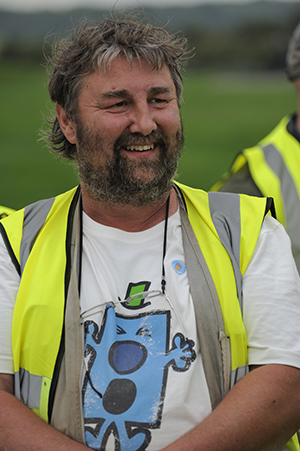
Prof. dr. Mike Parker Pearson
Mike Parker Pearson is Professor of British Later Prehistory at the Institute of Archaeology, University College London (UCL). He is a Fellow of the British Academy and has directed archaeological projects in Madagascar as well as in many parts of Britain. His books include The Archaeology of Death and Burial, Pastoralists, Warriors and Colonists and Stonehenge: investigating a Stone Age mystery.

Prof. dr. Joshua Pollard
Joshua Pollard is Professor of Archaeology at the University of Southampton. He is a leading authority on the Neolithic and Bronze Age in Britain, and is director of a major research project on the Neolithic stone circle complex at Avebury, where he has worked for many years. His books include Avebury: biography of a landscape, Landscape of the Megaliths and Avebury.

Prof. dr. Colin Richards
Colin Richards is Professor of Archaeology at the University of the Highlands and Islands in Scotland. He is a leading expert on stone circles and has excavated widely on Neolithic sites in Britain as well as on Easter Island and elsewhere in the Pacific. For many years he has been researching the Neolithic period in Orkney, where he is now based. His books include Dwelling among the Monuments, Building the Great Stone Circles of the North and The Development of Neolithic House Societies in Orkney.

Prof. dr. Julian Thomas
Julian Thomas is Professor of Archaeology at the University of Manchester. He is a leading expert on Neolithic Britain, and has directed excavations in many parts of Britain from Scotland to southern England. His books include Understanding the Neolithic, Time, Culture and Identity, and The Birth of Neolithic Britain.

Prof. dr. Chris Tilley
Chris Tilley is Professor of Anthropology at University College London (UCL). He has directed archaeological projects in Britain and has written widely on many topics including archaeological theory and phenomenology, for which he is known internationally. His books include A Phenomenology of Landscape, Metaphor and Material Culture, An Anthropology of Landscape and The Materiality of Stone.

Prof. dr. Kate Welham
Kate Welham is Professor of Archaeological Science at Bournemouth University. She has worked on projects in Britain, Kenya, Spain and Easter Island, and is a leading expert in geophysical survey as well as in archaeological materials. She is chair of the UK committee of archaeological heads of departments. She is co-author of Stonehenge: making sense of a prehistoric mystery.
Abstract:
For many centuries, scholars and enthusiasts have been fascinated by Stonehenge, the world’s most famous stone circle. In 2003 a team of archaeologists commenced a long-term fieldwork project there for the first time in decades. The Stonehenge Riverside Project (2003-2009) aimed to investigate the purpose of this unique prehistoric monument by considering it within its wider archaeological context.
This is the first of four volumes which present the results of that campaign. It includes investigations of the monuments and landscape that pre-dated Stonehenge on Salisbury Plain as well as excavation at Stonehenge itself. The main discovery at Stonehenge was of cremated human remains from many individuals, allowing their demography, health and dating to be established. With a revised radiocarbon-dated chronology for Stonehenge’s five stages of construction, these burials can now be considered within the context of the monument’s development. The different types of stone from which Stonehenge is formed – bluestones from Wales and sarsen silcretes from more local sources – are investigated both at Stonehenge and in its surroundings. These surrounding monuments include single standing stones, the Cuckoo Stone and the Tor Stone, as well as the newly discovered circle of Bluestonehenge at West Amesbury beside the River Avon. The ceremonial Stonehenge Avenue, linking Stonehenge to Bluestonehenge, is also included, with a series of excavations along its length.
The working hypothesis behind the Stonehenge Riverside Project links Stonehenge with a complex of timber monuments upstream at the great henge of Durrington Walls and neighbouring Woodhenge. Whilst these other sites are covered in a later volume (Volume 3), this volume explores the role of the River Avon and its topographic and environmental evidence.
With contributions by:
Umberto Albarella, Michael Allen, Olaf Bayer, Wayne Bennett, Richard Bevins, Christopher Bronk Ramsey, Chris Casswell, Andrew Chamberlain, Benjamin Chan, Rosamund Cleal, Gordon Cook, Glyn Davies, David Field, Charles French, Robert Ixer, Neil Linford, Peter Marshall, Louise Martin, Claudia Minniti, Doug Mitcham, Bob Nunn, Andy Payne, Mike Pitts, Rebecca Pullen, Julian Richards, David Robinson, Clive Ruggles, Jim Rylatt, Rob Scaife, Ellen Simmons, Charlene Steele, James Sugrue, Anne Teather, Sarah Viner, Tony Waldron, Katy Whitaker and Christie Willis
See the other volumes in the Stonehenge Riverside Project Series
Contents
LIST OF FIGURES
LIST OF TABLES
CONTRIBUTORS
PREFACE
ACKNOWLEDGEMENTS
1. Introduction
The Stonehenge Riverside Project
Background to the project
Implications of the hypothesis
Research aims
M. Parker Pearson, J. Pollard, C. Richards, J. Thomas C. Tilley, K. Welham and P. Marshall
2. Fourth millennium BC beginnings: monuments in the landscape
The landscape of the fourth millennium BC – (C. Tilley, W. Bennett and D. Field)
Geophysical surveys of the Greater Cursus and Amesbury 42 long barrow – (K. Welham, C. Steele, L. Martin and A. Payne)
3. Fourth millennium BC beginnings: excavations of the Greater Cursus, Amesbury 42 long barrow and a tree-throw pit at Woodhenge
The Greater Stonehenge Cursus – (J. Thomas)
Amesbury 42 long barrow – (J. Thomas)
Investigations of the buried soil beneath the mound of Amesbury 42 – (M.J. Allen)
Stonehenge Lesser Cursus, Stonehenge Greater Cursus and the Amesbury 42 long barrow: radiocarbon dating – (P. D. Marshall, C. Bronk Ramsey and G. Cook)
Antler artefact from the Greater Cursus and Amesbury 42 long barrow – (G. Davies)
Pottery from the Greater Cursus and Amesbury 42 long barrow – (R. Cleal)
Chalk artefact from the Greater Cursus – (A. Teather)
Lithics from stratified contexts of the Greater Cursus – (B. Chan)
Lithics from the ploughsoil of the Greater Cursus – (D. Mitcham)
Lithics from stratified contexts of Amesbury 42 long barrow – (B. Chan)
Human remains from Amesbury 42 long barrow and the Greater Cursus – (A. Chamberlain and C. Willis)
Charred plant remains and wood charcoal from the Greater Cursus and Amesbury 42 long barrow – (E. Simmons)
Woodhenge tree-throw pit – (J. Pollard)
Pottery from the Woodhenge tree-throw pit – (Rosamund M.J. Cleal)
Lithics from Woodhenge – (B. Chan)
Faunal remains from Woodhenge – (C. Minniti, U. Albarella and S. Viner)
Charred plant remains and wood charcoal from Woodhenge – (E. Simmons)
4. The Stonehenge bluestones: excavations at Stonehenge and environs
The bluestones at Stonehenge – a reappraisal – (M. Parker Pearson and C. Richards)
Aubrey Hole 7 at Stonehenge: Trench 39 – (M. Parker Pearson, B. Chan, C. Casswell, M. Pitts and J. Richards with R. Ixer)
Fargo bluestone scatter – (C. Richards, J. Pollard, D. Robinson and M. Parker Pearson)
Airman’s Corner pit circle – (M. Parker Pearson)
5. Bluestonehenge at West Amesbury: where the Stonehenge Avenue meets the River Avon
Research background and pre-excavation investigations – (M. Parker Pearson, K. Welham, C. Steele, A. Payne, L. Martin, D. Mitcham and C. French)
Archaeological excavations of Bluestonehenge within West Amesbury henge – (M. Parker Pearson, R. Nunn and J. Rylatt)
Radiocarbon dating of Bluestonehenge and West Amesbury henge – (P. Marshall, C. Bronk Ramsey and G. Cook)
Neolithic and Beaker pottery – (R. Cleal)
Lithics from stratified contexts – (B. Chan and J. Rylatt with P. Pettitt)
Other artefacts of stone, antler and bone – (M. Parker Pearson with G. Davies and R. Ixer)
Faunal remains – (C. Minniti, U. Albarella and S. Viner)
Charred plant remains and wood charcoal – (E. Simmons)
6. Sarsens at Stonehenge
Stonehenge reworked – sarsen construction – (C. Richards and M. Parker Pearson)
The sarsen-dressing area (Trench 44) – (B. Chan and C. Richards)
The flint assemblage from the sarsen-dressing area – (B. Chan)
Sarsen stone from Trenches 44 and 45 – (B. Chan)
Sarsen-working at Stonehenge – (K. Whitaker)
7. Sarsens in the Stonehenge landscape
Sarsen origins within the landscape – (C. Richards, K. Whittaker, M. Parker Pearson, C. Tilley and W. Bennett)
The Cuckoo Stone – (C. Richards)
Geophysical surveys of the Cuckoo Stone – (K. Welham and C. Steele)
Lithics from the ploughsoil – (D. Mitcham)
Excavation – (C. Richards)
Cuckoo Stone radiocarbon-dating – (P. Marshall, C. Bronk Ramsey and G. Cook)
Lithics from stratified contexts – (B. Chan)
Antler artefacts from the Cuckoo Stone – (G. Davies)
Faunal remains from the Cuckoo Stone – (C. Minniti, U. Albarella and S. Viner)
Charred plant remains from the Cuckoo Stone – (E. Simmons)
Wood charcoal from the Cuckoo Stone – (E. Simmons)
The Tor Stone, Bulford – (C. Richards)
Geophysical survey of the Tor Stone at Bulford – (K. Welham and C. Steele)
Extraction and erection of the Tor Stone – (C. Richards)
Charred plant remains and wood charcoal from the Tor Stone, Bulford – (E. Simmons)
8. The Stonehenge Avenue
Geophysical surveys – (K. Welham, C. Steele, N. Linford and A. Payne)
The Stonehenge Avenue at Stonehenge (Trench 45) – (M. Parker Pearson and R. Pullen)
Geology, geomorphology and buried soils – (M. Allen and C. French)
The Stonehenge Avenue Bend ((Trenches 46, 47, 48, 57, 58 and 59) – (D. Robinson and O. Bayer)
The Stonehenge Avenue’s ‘northern branch’ (Trench 56) – (M. Parker Pearson and A. Teather)
Radiocarbon dating of the Stonehenge Avenue – (P. Marshall, C. Bronk Ramsey and G. Cook)
Lithics from the Avenue in front of Stonehenge (Trench 45) – (B. Chan)
Lithics from the Avenue bend and the Avenue’s ‘northern branch’ – (B. Chan)
Lithics from the ploughsoil of the ‘northern extension’ – (D. Mitcham)
Chalk artefact – (A. Teather)
Charred plant remains and wood charcoal from the Stonehenge Avenue – (E. Simmons)
The orientation of the Stonehenge Avenue and its implications – (C. Ruggles)
The Avenue’s construction and purpose – (M. Parker Pearson)
9. Stonehenge and the River Avon
Along the River Avon – (C. Tilley and W. Bennett)
The Avon palaeo-channel – (C. French and M.J. Allen)
Palynology – (R. Scaife)
10. The people of Stonehenge
Human osteology – (C. Willis)
Radiocarbon dating of human remains from Stonehenge – (P. Marshall, C. Bronk Ramsey and G. Cook)
11. Radiocarbon dating: the Stonehenge modelling and results
P. Marshall, C. Bronk Ramsey, G. Cook and M. Parker Pearson

Prof. dr. Mike Parker Pearson
Mike Parker Pearson is Professor of British Later Prehistory at the Institute of Archaeology, University College London (UCL). He is a Fellow of the British Academy and has directed archaeological projects in Madagascar as well as in many parts of Britain. His books include The Archaeology of Death and Burial, Pastoralists, Warriors and Colonists and Stonehenge: investigating a Stone Age mystery.

Prof. dr. Joshua Pollard
Joshua Pollard is Professor of Archaeology at the University of Southampton. He is a leading authority on the Neolithic and Bronze Age in Britain, and is director of a major research project on the Neolithic stone circle complex at Avebury, where he has worked for many years. His books include Avebury: biography of a landscape, Landscape of the Megaliths and Avebury.

Prof. dr. Colin Richards
Colin Richards is Professor of Archaeology at the University of the Highlands and Islands in Scotland. He is a leading expert on stone circles and has excavated widely on Neolithic sites in Britain as well as on Easter Island and elsewhere in the Pacific. For many years he has been researching the Neolithic period in Orkney, where he is now based. His books include Dwelling among the Monuments, Building the Great Stone Circles of the North and The Development of Neolithic House Societies in Orkney.

Prof. dr. Julian Thomas
Julian Thomas is Professor of Archaeology at the University of Manchester. He is a leading expert on Neolithic Britain, and has directed excavations in many parts of Britain from Scotland to southern England. His books include Understanding the Neolithic, Time, Culture and Identity, and The Birth of Neolithic Britain.

Prof. dr. Chris Tilley
Chris Tilley is Professor of Anthropology at University College London (UCL). He has directed archaeological projects in Britain and has written widely on many topics including archaeological theory and phenomenology, for which he is known internationally. His books include A Phenomenology of Landscape, Metaphor and Material Culture, An Anthropology of Landscape and The Materiality of Stone.

Prof. dr. Kate Welham
Kate Welham is Professor of Archaeological Science at Bournemouth University. She has worked on projects in Britain, Kenya, Spain and Easter Island, and is a leading expert in geophysical survey as well as in archaeological materials. She is chair of the UK committee of archaeological heads of departments. She is co-author of Stonehenge: making sense of a prehistoric mystery.
-
Digital & Online access
This is a full Open Access publication, click below to buy in print, browse, or download for free.
-
Buy via Sidestone (EU & UK)
-
Buy via our Distributors (WORLD)
For non-EU or UK destinations you can buy our books via our international distributors. Although prices may vary this will ensure speedy delivery and reduction in shipping costs or import tax. But you can also order with us directly via the module above.
UK international distributor
USA international distributor
- Browse all books by subject
-
Search all books

We will plant a tree for each order containing a paperback or hardback book via OneTreePlanted.org.
You might also like:
© 2025 Sidestone Press KvK nr. 28114891 Privacy policy Sidestone Newsletter Terms and Conditions (Dutch)
